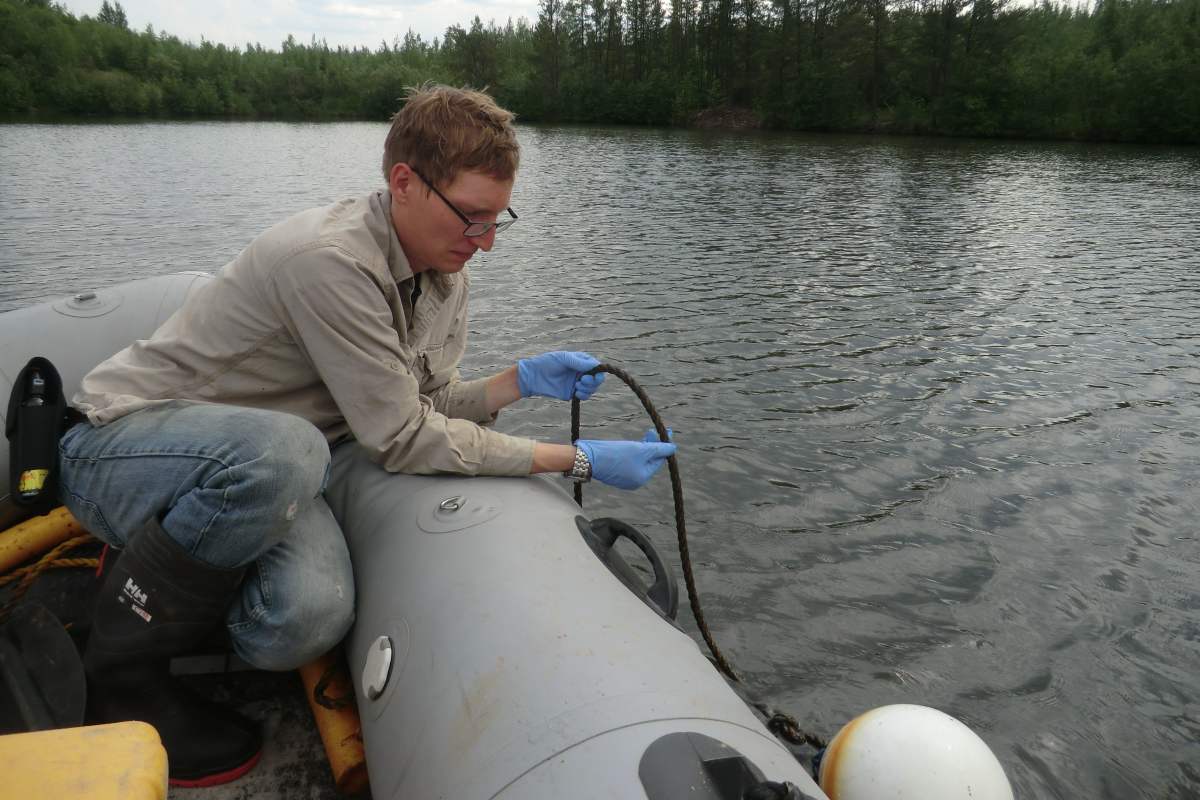
Konstantin von Gunten is pictured here conducting field work at the Cluff Lake uranium mine site.
New research by University of Alberta scientists aims to understand the risks for metal contamination at an inactive mining site in Northwestern Saskatchewan—helping to inform strategy for a safe long-term reclamation of the site.
The research team examined two environments at the Cluff Lake uranium mine site: two man-made mine pits and naturally occurring wetlands. Their results suggest that dispersed, nano-particles in water, also called colloids, play an important role in understanding the long-term stability of the site—despite the fact that they are not examined during traditional monitoring practices.
“Normal practice in consulting does not include looking at these particles, but skipping this step may cause us to miss some of the ways metals, such as uranium and nickel, may disperse at the site,” said Konstantin von Gunten, a postdoctoral fellow in the Department of Earth and Atmospheric Sciences. “Over time, these tiny particles containing metals may begin to collect and form into precipitating particles that could settle and accumulate forming contaminated sediments.”
The formation and stability of colloids were not only affected by the chemical composition of the corresponding environments. They were tightly linked to microbiological processes. This makes it especially challenging to model and predict their behaviour.
The Cluff Lake uranium mine has been inactive for nearly two decades. University of Alberta scientists worked to better understand the long-term stability of metals at the site and consult on best practices for remediation.
“Uranium and nickel residue left over during the mining process are the main concern here,” explained von Gunten, who conducted this research as part of his PhD studies with Associate Professor Daniel Alessi. “We want to understand what will happen with these metals over time. Will they stay in place? Or will they begin to affect surface and groundwater in the surrounding environment? The more data that can be obtained through monitoring and scientific work, the better the decisions that can be made about the reclamation of the mine.”
While extensive research is still required, these studies contribute to building recommendations for testing and monitoring in the region. “For sites with similar environmental factors, this research could be an excellent model for building a strategy for testing and monitoring contaminants,” added Alessi, Encana Chair in Water Resources.
For Cluff Lake, the research also feeds into a long-term monitoring plan, helping to identify the type of equipment and method of monitoring that might be useful in the region. And building this understanding is important, as Canada is the world’s second largest producer of uranium.
This research project was co-led by Alessi and Kurt Konhauser, professor in the Department of Earth and Atmospheric Sciences. Funding for this study was provided by the Natural Sciences and Engineering Research Council of Canada (NSERC), and UAlberta North.
The first paper, “Biogeochemistry of U, Ni, and As in two meromictic pit lakes at the Cluff Lake uranium mine, northern Saskatchewan,” was published in The Canadian Journal of Earth Sciences (doi: 10.1139/cjes-2017-0149). The second paper, “Biogeochemical behavior of metals along two permeable reactive barriers in a mining-affected wetland, was published in the Journal of Geophysical Research - Biogeosciences(doi: 10.1029/2019JG005438). The third paper, “Colloidal transport mechanisms and sequestration of U, Ni, and As in meromictic mine pit lakes,” was published inGeochimica et Cosmochimica Acta (doi: 10.1016/j.gca.2019.09.015).